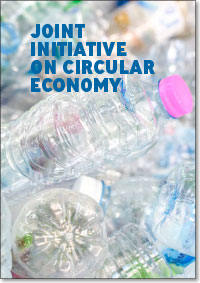The transition towards a circular economy can help reduce environmental impact, but also bring major economic benefits, contributing to innovation, growth and job creation.
The EU bank embraces the potential of a circular economy and we support the public and private sector in their circular transition.
We also support cities with guidance documents, webinars and advisory programmes through the Circular City Centre (C3).
How we lead the way to circular action and sustainable growth
EIB’s support to the circular economy transition builds on three mutually reinforcing sets of activities:
We develop and share knowledge and we raise awareness on the circular economy transition by:
- improving the framework conditions for circular economy financing, for example through involvement in multi-stakeholder circular economy fora,
- preparing studies to identify market barriers and funding gaps,
- preparing circular economy guidance material and documents,
- knowledge sharing and capacity building, by organising for instance conferences.
We help the promoters of circular projects mitigate risks and improve the investment readiness of their projects. Here is how we do this:
- we support circular economy strategies and project pipeline development targeting particular cities,
- we support the preparation of circular projects, for both public and private sector promoters,
- we review circular projects, we identify gaps/weaknesses and we advise on improvements,
- we advise on financing options within and outside the EIB Group, and
- we facilitate contacts to relevant market actors.
The above services are provided via the InvestEU Advisory Hub and the Circular City Centre (C3).
We have a wide range of financing products and instruments that match the characteristics of different circular promoters and projects, including innovative circular businesses with a higher risk profile.
We also apply our financing expertise by:
- leveraging horizontal (market) studies to further define funding gaps,
- recommending internal EIB-managed instruments and/or Investment Platforms (IP), where necessary,
- structuring/implementing Investment Platforms that mobilise public/private investors.
Discover our financing products.
Types of circular economy projects
Circular design and production
Strategies: reduce, recycle
Smart design and production that reduce waste and recycle materials at the beginning of a product's lifecycle are essential to ensure circularity.
Circular use and life extension
Strategies: reuse, repair, repurpose, refurbish, remanufacture
Business models that increase the value and use of a product during an extended life are essential to shift to a circular economy. Over time, extending product life through proper care and repair reduces the need for people to buy more.
Circular value recovery
Strategies: recycle, recover
Value recovery models aim to maximise recovery and recycling of a product after its end-of-life stage. The value recovery models reduce waste and conserve resources.
Circular support
Strategies: reduce, recycle, reuse, repair, repurpose, refurbish, remanufacture, recover
Support and facilitation of all circular strategies in all lifecycle phases.

The transition to circular cities
Cities have an important role to play in the transition to a circular economy. They host most of the world’s population, generate about half of the planet’s waste and consume 70% of all resources and energy. For information and support on how to finance circular economy in an urban context, visit the website Circular City Funding Guide.
The EIB, together with the InvestEU Advisory Hub and the European Commission, is also supporting cities in their circular economy transition through the Circular City Centre (C3), which offers guidance documents, webinars and circular city and project advisory programmes.
But what does a circular city look like? Find out in this video.





